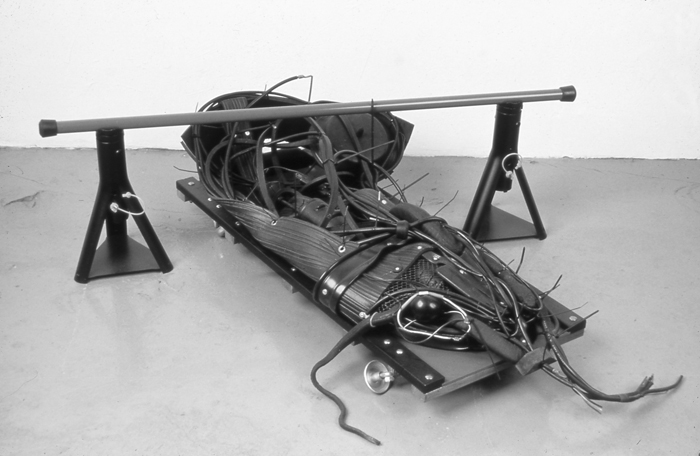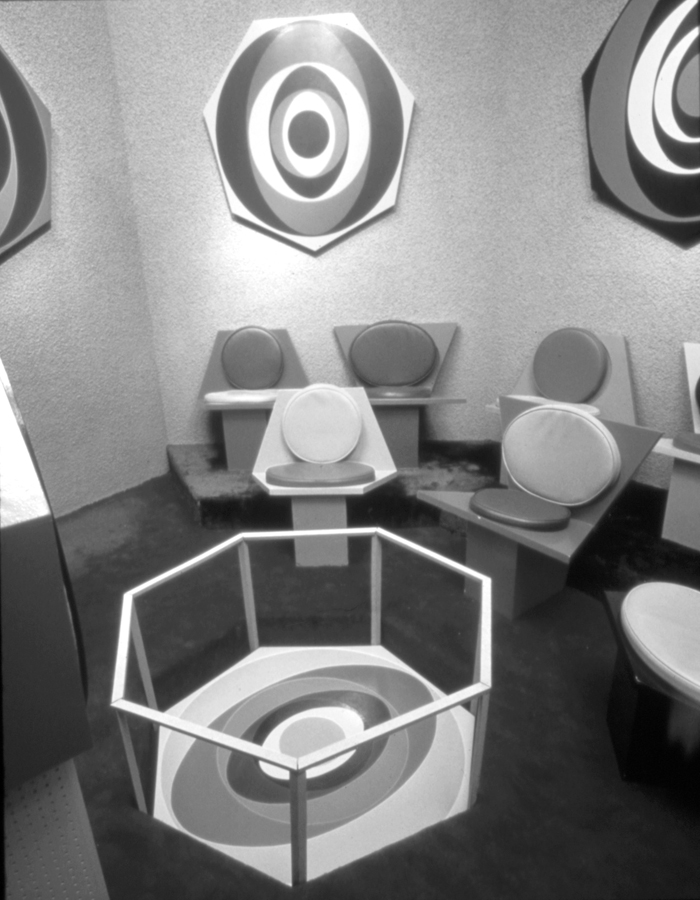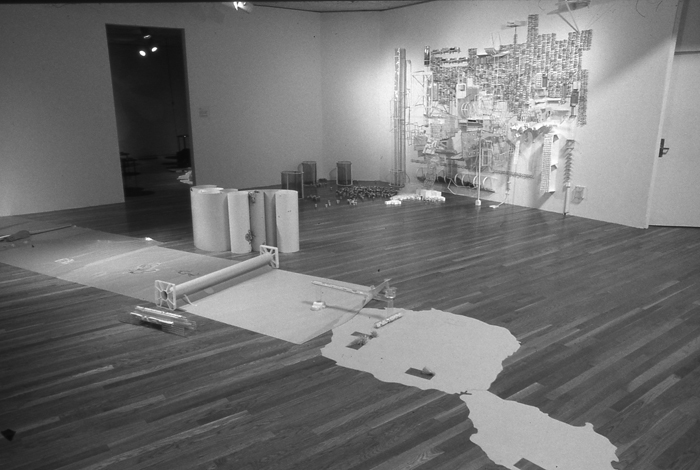THE GIST OF ISNESS
What “is” in the authentic sense also resists every onsurge of becoming.
—Martin Heidegger, An Introduction to Metaphysics1
While chatting with philosopher and art critic Arthur Danto back in 1998, I suddenly realized that his aboutness criteria, for which an embodied meaning “shows” what the work is “about” ran contrary to my view of the interpretation process. For Danto, aboutness serves as the rhetorical device that distinguishes art (a favorite example of his being Andy Warhol’s Brillo Box) from non-art (a cardboard Brillo box). According to Danto’s criteria, Warhol’s box is art because it exhibits aboutness, as if Warhol meant to furnish commentaries concerning attractive design, Minimalism’s archetypal boxes, an era’s “style,” and capitalism’s role in harnessing good design or commercial strategies. In the course of the conversation I found myself wondering, “Yes, but what about those inscrutable sensorial events that tend to arouse audience discomfort?” The utterly “meaningless” status of unfamiliar art coerces commentary from viewers eager to transform formidable chaos into remarkable experiences. Incidental catalysts for later revelations, avant-garde art always inspires ideas, provokes thoughts or gets absorbed as ineffable perceptions. In creating sensorial scenarios that rarely duplicate existing experiences, artists alter our knowledge of the world, as we conspire to make sense of it all. Isness characterizes the art experience and complements aboutness, which occurs more as an afterthought of the art experience.

Caryl Davis, The Ground is Good (Slump), Kodachrome, 30 x 20 inches, 1995.
Since Danto extrapolates far more than he interpolates, any implication that one can retrieve some prior referent, explanatory concept, or ideal interpretation whole cloth from an “embodied meaning” proves misleading. Artworks are never readable like texts, even when one has access to interpretive schemes such as symbols and metaphors, local culture, categorizing movements, background information, thematic exhibitions, or historicizing eras. Ready access to a work’s meaning typically indicates that it has already entered art history. As Marcel Duchamp once noted, after 40 or 50 years a work stops being art and becomes art history.
Given philosopher Ludwig Wittgenstein’s assertion that interpretations are no property of objects, one wonders whether Danto’s requirement that interpretations be “embodied,” like the properties “red” or “soft,” helps to differentiate artworks from ordinary objects. “Meaningful” art objects would thereby be distinguished from “meaningless” non-art objects. However, since unfamiliar art always seems “meaningless,” such a distinction is rendered moot. Moreover, some philosophers have argued (in response to Danto’s aboutness criteria) that anything can elicit an interpretation, so perhaps interpretations are no more a property of art than they are of objects.2 There is thus no there there to retrieve, only sensorial objects awaiting ascriptions.

John Souza, The Word (Virginoid) Would not Exist, 1989. Mixed media, 14 x 44 x 40 inches.
While describing isness to others, I have noted how art that sustains isness resists aboutness. By extension, artworks that thwart pat interpretive schemes survive longer as art in their refusal to enter art history. Artworks that are deemed “strong” exhibit isness since they are more difficult to grasp (let alone explain or get under). The distinction between nonsense and “strong” art is that the latter engenders cognition. Existentialist philosopher Martin Heidegger proposed a similar theory when he noted that “what is” resists becoming (although he was describing the resistance of being to becoming, not the resistance of artworks to art history!). Ever since Heidegger reversed the phenomenological prioritization of an object’s objective presence over its equipmental value (use, meaning or reference), engagement has aimed for meaning. Both Heidegger’s equipmental value and Danto’s aboutness criteria propose that meaning-making is easily achievable, while isness acknowledges from the onset that viewer confusion is a natural condition, given an artwork’s “subjective” presence. Irrespective of era, the concept of isness dramatizes unfamiliar forms emerging against the grain, while aboutness requires familiar schemes. Works that exhibit isness engender particularized events, startle viewers, and plant memories that facilitate future awareness, thus casting doubt on the representationality of art.
THE AVANT-GARDE CONDITION
Works of art (visual, literary or musical) that offer experiences not otherwise encountered are priceless, as they manifest heretofore nonexistent aesthetic possibilities. Such scenarios are characterized as avant- garde. Originally a military term, the avant-garde is literally the first flank to enter battle. Metaphorically, it has come to describe the first to break with rank and file. No wonder Heidegger, who said, “The violence that originally creates the path engenders its own mischief of mentality,” linked creativity with aggression.3 Avant-garde art, as the term is used here, excludes works that illustrate articulated agendas (manifestos or pre-existing theories), yet welcomes artists’ accounts that follow production.
Avant-garde practices persist despite the absence of ready-made interpretations that might grant them meaning or justify them as art worthy. Awareness provokes one to seek out illumination. Wittgenstein coined the notion of “seeing the figure as a box,” to show how figuration depends on one’s awareness of some “box” concept, such as a cube or a storage container.4 Aboutness presumes one’s ready access to some box concept, while isness anticipates it. Viewers who lack box-consciousness, yet happen upon a work that evokes “boxness,” are so startled by the misfire that they either seek out information through such activities as reading articles, chatting with friends, or attending lectures to attain some kind of “box illumination” or are jettisoned back to prior moments of “box ignorance,” until such a time that they are ready to glean “box clarity.” Either scenario characterizes art’s cognitive role. Even works that evoke “boxness,” yet fail to fully illuminate box concepts can play an invaluable role in provoking box-consciousness.
Today, few doubt whether Warhol’s Brillo Box, Heinz Tomato Ketchup Box, Mott’s Apple Juice Box, Kellogg’s Corn Flakes Box, Delmonte Peaches Box and Campbell’s Tomato Juice Box (all of which originally appeared together in his 1964 exhibition at the Stable Gallery in New York) are art objects. Such works, especially Brillo Box, have inspired a multitude of interpretations though none illustrates outright the commentaries that have been assigned to them. Wittgenstein refers to “the dawning of the aspect” to describe how we notice different attributes each time we regard an object, as compared to the “continuous seeing” of an aspect.5 Wittgenstein’s notion of “seeing the figure as a box” comes alive, for example, every time one regards a Donald Judd sculpture. No wonder minimalists stressed the box-situation (body + object + space + light) to maximize box- cognition (the viewer’s intellectual engagement). By insuring that we see something unusual each time we regard their works, minimalists have fostered the “dawning of an aspect,” thereby reinforcing art’s role as a catalyst for cognition. Once we stop seeing the new aspects of an art object, chances are it has entered art history and has lost “the power to cause things to happen,” let alone inspire thought.6

Jim Isermann, Futura, 1987. Wood, enamel paint; dimensions variable.
Isness is characteristic of fresh aesthetic events that resist Heideggarian “becoming” by refusing to duplicate ordinary experience. Even though Warhol’s silk-screened plywood boxes reference real things, his presentation was particu- larly fresh. In 1964, the “stack” as a sculptural form had no antecedents. At the time, only grocery clerks would have recognized such facsimiles. Serialized and repetitively placed in the gallery, Warhol’s mundane boxes interjected an unanticipated concept (artificiality as a construct) into the ongoing art historical discussion concerning the role of originality in art. Indicative of isness, these works appeared unprincipled. This comes as no surprise, since unfamiliar art causes tension and problematizes existing standards. When avant-garde works introduce new standards, their creators are rarely conscious of the rules or ideas their works supposedly articulate. Such works are said to show—rather than express—new rules, values, beliefs, and concerns. Since seeing a work as “whatever” provokes “whatever”-consciousness, interpretation reveals far more about the interpreter than the art at hand.
Isness identifies the presence of those material effects that both stimulate writers to excavate the extra-material and ground art’s antirepresentational status. Even stranger, such works become models, even as they resist imitation. Henri Bergson recognized this phenomenon when he wrote, “It is true that an image may be without being perceived—it may be present without being represented— and the distance between these terms, presence and representation, seems just to measure the interval between matter itself and our conscious perceptions of matter.”7 Isness is not an anti-theory theory, nor does it support the view that “what you see is what you see.” Isness rather accounts for art’s status (it just is), quarantined in a state of ineffability or inscrutability.

Richard Hawkins, City Underground, 1997. Mixed media, 26.75 x 30.5 x 30.5 inches.
Not surprisingly, when a dissonant work commands attention, it offers a compelling object of study. However, it should be remembered that art writing posits a representational account, no matter how ineffable or inscrutable the work once was. When works become attached to particular theories, they often lose their meaninglessness. Exacerbating the loss is the way in which art lovers discuss what works mean or how they function as if these attributes were somehow separate from how one actually experiences them. Wittgenstein termed this “seeing an object according to an interpretation.”8 The rhetoric surrounding the production of abstract paintings in the ‘40s or ‘50s offers vivid examples of this phenomenon. Clement Greenberg’s claim that painting had become flatter and flatter over the centuries encouraged people to see paintings by Joseph Albers, Ad Reinhardt, and Morris Louis as flat, even though they depict illusionary space, stealthily rendered without dimensions. One could alternatively set out to prove that such works have actually taught viewers how to extrapolate space from planar surfaces, a feat that, as I have argued elsewhere, enabled computer engineers to apply this different aspect (à la Wittgenstein) to envision cyber-graphics.9
At stake is the priority of art (rather than the running commentary) and the ideas particular works manifest over time and in specific locales. Paradoxically, ever since Wittgenstein observed that “[A work] of art does not aim to convey something else, just itself,”10 a work’s discourse has most often overshadowed its aim. Works that eschew art history and continue to inspire numerous albeit conflicting interpretations remain relevant to viewers from different eras for varying reasons.

Kahty Chenoweth/Lynne Berman, Distratic Center for Budget Crapilene, 1994. Mixed media, dimensions variable.
In privileging aboutness, Danto never intended to restrict meaning or to exclude competing interpretations. However, his criteria —which focuses on “showing” and readily available referents, despite art’s inexorable inexpressibility—overlooks how meaning changes in relationship to time, as we gain awareness of ever more concepts. To return to the abstract painting example, aboutness invites both interpretations, however conflicting, so long as one can demonstrate “embodiment.” Thus, mid-century abstract paintings exemplify both Greenberg’s theory of flatness and painterly attempts at dimensionless, spatial rendering. It is most problematic, however, to prove the latter interpretation is “embodied” when such a deter- mination requires acute perceptual capabilities. Because aboutness is not inherent in works and therefore requires an understanding of prior concepts, its effect remains at a remove for uninformed viewers. By comparison, isness encapsulates whatever concepts one’s actual engagement with the work illuminates. Furthermore, isness anticipates a work’s future meanings by allowing us to adjust our impressions as they develop over time.
The presence of art enables spectators to become cognizant of notions, values, and beliefs that they would not have considered otherwise. Wittgenstein affirmed art’s role when he remarked, “It’s only by thinking more crazily than philosophers do that you can solve their problems.”11 Finally, avant-garde movements periodically pop up to reconnect art to the world. A novel art event’s liveliness, deadliness, or indifference assures its place among vital experiences, what Heidegger termed being. His statement, “nonbeing has no is,” incidentally links isness to being.
THE PHENOMENA OF BEING STRUCK
Labour pains at the birth of new concepts.
— Ludwig Wittgenstein, Culture and Value12
Wittgenstein was careful to point out that one observes more than what comes into being through observation. Since the “object of observation is something else… ‘observing’ does not produce what is observed.”13 When the “object of observation” is meaning-making, as Heidegger and Danto posit, sensorial being risks negation. We hurl art into the heap of art history whenever “a concept forces itself on one.”14 An unfortunate after effect is our willingness to see artwork only according to its interpretation and thereby divorce meaning from experience. By extension, once our focus is directed towards an assigned meaning no one bothers to look at the actual artwork anymore. By comparison, since the gist of isness is aesthetic experience, the startling effects of unrecognizable concepts continue to pique our curiosity and “cause things to happen,” however delayed. Only after a great deal of time is put in by lots of thoughtful viewers do interpretations arise from a state of utter confusion. This is no less the case now than fifty years ago when Wittgenstein remarked, “We find certain things about seeing puzzling, because we do not find the whole business of seeing puzzling enough.”15

Shirley Tse, Sprawl, 2000/02. Mixed media, dimensions variable.
If, as philosopher John Searle believes, memories are stored in the synaptic connections between neurons, then the entire body acts as a live sensor that perceives experiences (visual, acoustic, olfactory, tactile, and gustatory) and records them.16 The body as sensor simultaneously triggers related non-linguistic memories that are stored and distributed all over the body. There is no causal connection between memory and perception, because memories influence perceptions and vice-versa. However, one’s ability to organize perception (cognition) is shaped by a given body’s capacity to access and process memories of one’s experiences. In this respect, the inanimate art object, like the human body, is a physical object that exerts forces on live bodies. One wonders whether the ability to access the thousands of memories written on one’s body (stored as unconscious traces or subconscious thoughts) depends upon one’s knack for abandoning conscious preoccupations that inhibit thinking and repress memory. Activities such as meditation, concentration, trances, driving, exercise, hypnosis, relaxation techniques, and speech all serve to shake free forgotten information.
When an unfamiliar aesthetic event (what Wittgenstein called a puzzle-picture) is encountered, one’s attention is often so focused upon deciphering the experience that one often lacks the time or energy to interpret the sensory aspects of what is actually being experienced. Such events ensure a new beginning “with all the strangeness, darkness, insecurity that attend a true beginning.”17 Wittgenstein termed this moment of confusion the “phenomena of being struck.”18 As mentioned previously, one must be aware of related concepts to recognize them, let alone express something about them. Since Wittgenstein connected representation (description, interpretation, or thought) to what is seen, unfamiliar experiences that defy expression therefore avoid representation. He noted how seeing a new aspect or seeing it differently “produces a surprise not produced by the recognition.”19 This tension, surprise, or sting initiates the storage of memory as well as its later retrieval.
The aesthetic event’s sensoriality and imaginative spirit command one’s attention long enough to inspire the kind of thinking that reboots the mind. Extraordinarily complex experiences produce knowledge that endures, providing a challenge to think differently, to question prior judgments, to refresh one’s knowledge base, all of which inevitably alters reality. To think so hard about something so inexplicable requires remarkable conviction. Since believing is a state of mind that requires duration20 one constantly shifts one’s beliefs over time. Sense-impressions can be hugely misleading, yet one never mistrusts beliefs.21 While a theory of aboutness accommodates the truthfulness of beliefs about sense-impressions, the experience of isness reveals how our reliance on others to ascertain meaning can foster erroneous beliefs. False sense-impressions are perpetuated at the institutional level by the presentation of inaccuracies in museum or gallery press releases and didactic panels. Art critics and theorists who fail to perceive or correct misinformation often reinforce it. To give a pungent example, how many think artist Wim Delvoye’s work, Cloaca (2002), stinks because someone erroneously reported that it smells?
ISNESS AND ANTIREPRESENTATIONALITY
Now, if in the judgment of taste the imagination must be considered in its freedom, it is in the first place not regarded as reproductive, as it is subject to the laws of association, but as productive and spontaneous (as the author of arbitrary forms of possible intuition).
–Immanuel Kant, The Critique of Judgement22
Theoretical scientists, creative writers, and visionary philosophers use language to explore novel concepts, while artists produce original works in whatever medium suits their needs. All four fields generate antirepresentational theories (productive and spontaneous, as opposed to reproductive), the underlying concepts of which rarely reference proven facts. The primary proponent of antirepresentationalism is American philosopher Richard Rorty, who probably never considered applying it to the visual arts. Rather, he directs it towards other forms of inquiry such as science, literature, and philosophy, fields in which “extraordinary” theories anticipate rather than represent reality. According to Rorty, the linguistic terms of language-based fields—such as theories, proofs, or narratives — cannot represent non-linguistic experience, such as observation or sensory data. The visual arts happily avoid this problem until artworks require explication. In his conception of antirepresentationalism, Rorty does not view knowledge as a matter of “getting reality right, but rather as a matter of acquiring habits of action for coping with reality.”23 If those who engage in interpretative practices could admit to antirepresentationality, they might minimize their antagonistic relationships with readers who scoff at the absurdity of their claims.

Maura Bendett, Object Resemblance, 1997. Plaster, wire, acrylic and paper; 252 x 85 x 12 inches.
One could extend Rorty’s brand of antirepresentationalism to all exemplary events that inspire unprincipled imaginations to introduce unusual concepts, however unconsciously. Such events cannot be said to represent whatever activities they inspire. Most forms of theoretical physics are antirepresentational, that is, they model phenomena that may be measurable some day with instruments like a radio telescope or a spectrum of refracted light, but characterize something currently radically invisible and purely speculative. Works that exhibit isness share in the antirepresentational spirit of theoretical physics. Ineffable, inscrutable, and non-specific objects defy art historical logic and known aesthetic categories. Amazingly, some works manage to uphold antirepresentationality for a long time, which lends them the status of an unsolvable riddle, like Mona Lisa’s smile or a Wittgensteinian puzzle-picture.
Finally, when an artwork jettisons art history along its twists and turns, its future impact is typically not immediately observable. Who, for example, could have looked at Mike Kelley’s work in 1986, Cady Noland’s in 1987, or Polly Apfelbaum’s in 1989 and been able to judge the impact that such works would have on future artistic practice? Demonstrating history’s vulnerable pact with present situations, Heidegger described how history as happening is “an acting and being acted upon which pass through the present, the present that vanishes in happening.”24 Similarly, significant artworks enrapture viewers’ imaginations, transporting them far beyond the realm of ready delight. The unfamiliar object’s capacity to distort time and reshape art history parallels its effect as a physical body subject to the laws of motion known as dynamics.
A Cincinnati-based curator and lecturer, Sue Spaid recently visited thirty-two states this fall to inspire interest in the ideas explored in her forthcoming collection of philosophical essays, Delay in Meaning: Essays in Isness, Antirepresentationality and Experientialism.
